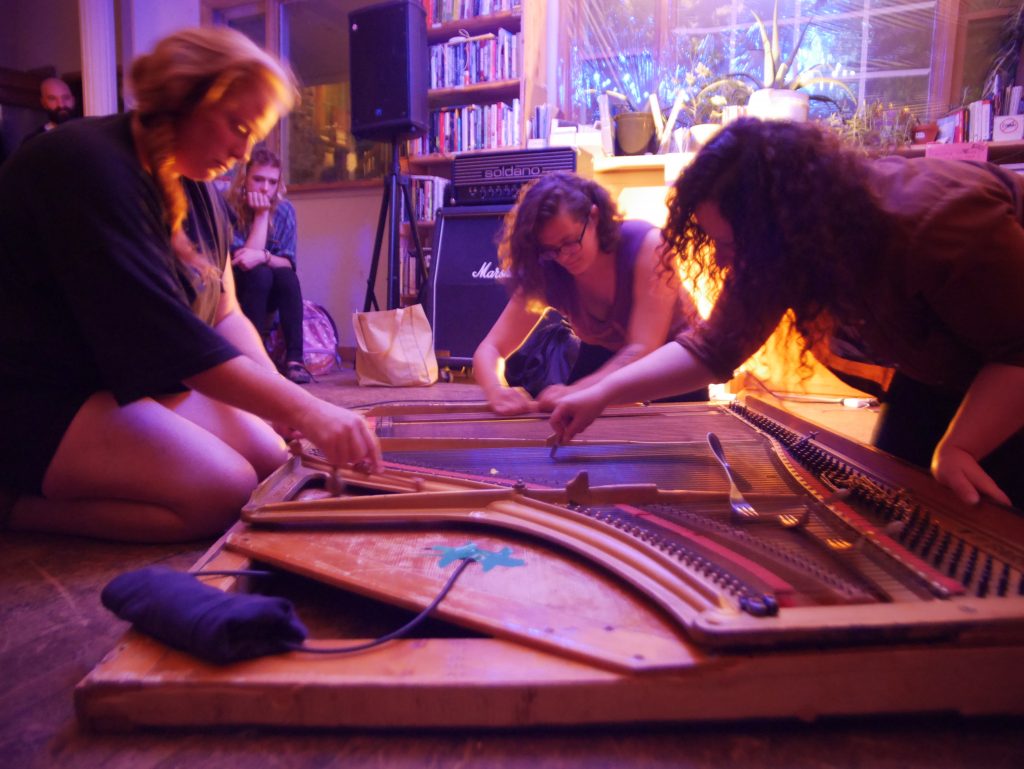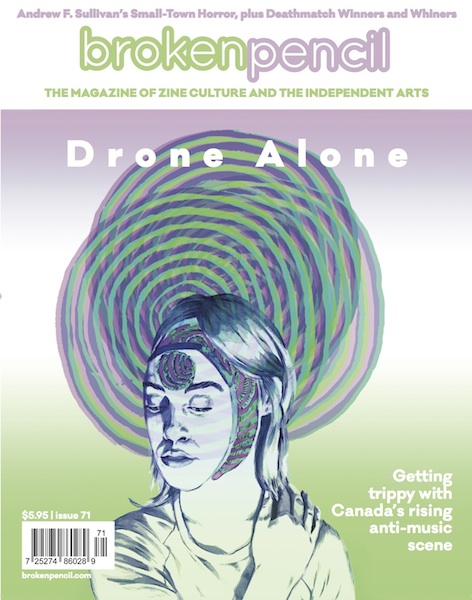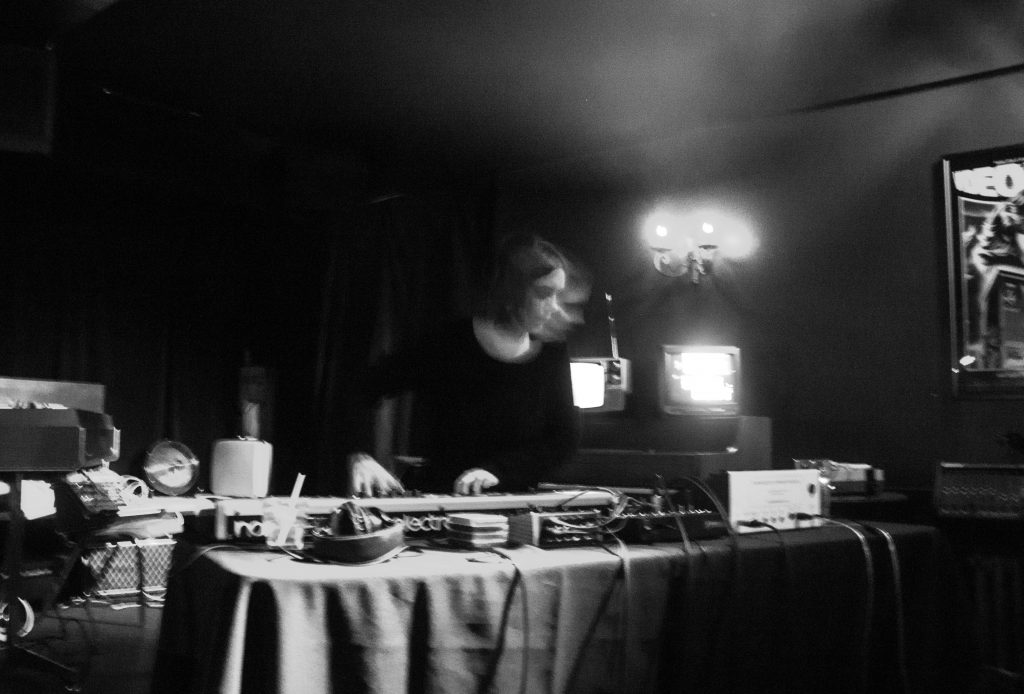In 2014, artist and activist Marie LeBlanc Flanagan announced a new Canadian holiday. Henceforth, she proclaimed on her popular underground music website Weird Canada, one Saturday in May would be known as National Drone Day. (This year’s event takes place this Saturday, May 28.) The idea, based on the niche music subgenre known as “ drone,” took off. Drone Day is now coming up on its third anniversary, with events happening from St. John’ s to Winnipeg to Yellowknife. “ I wasn’t expecting people to response to Drone Day as passionately as they have,” Leblanc Flanagan says. “ I love the idea of drones stretching from coast to coast.”
The idea of experimental anti-music gained traction well before the rise of punk rock, and people have been referring to a genre of music labeled drone since the ‘60s. Lately, drone is experiencing an awakening and resurgence, increasingly moving from bedroom confines to live performances in DIY venues and dive bars.
“When I started playing this music no one had any idea what it was,” says Toronto musician Jess Forrest, who performs as Castle IF. “And now I can go to a bar and overhear people talking about drone music. To me that’s an indicator that something is happening.”
Marie LeBlanc Flanagan
The National Drone Day concept has varied from city to city, from more traditional concerts to sprawling drone jams, pancake breakfasts, a 2014 digital compilation titled “ Drones Against Drones” that addressed the concept of drones in warfare (with proceeds going to aid imprisoned Wikileaks whistleblower Chelsea Manning), and at least one outdoor performance performed to an audience of no one: soloist Sam Therapy’s concert on Salt Spring Island, BC.
Shortly after the first National Drone Day came the birth of Toronto’s ongoing Casual Drones series, where local performers who may or may not have ever performed live drone before play in a relaxed bar setting. The event continues to bring out curious new faces. “Tonight I learned that I like drone music!” I overheard at the January edition, as a friend Snapchatted a slow moving psychedelic light installation. In 2016, drone’s multi-faced appeal means you’ re as likely to find it at a dingy DIY basement show as playing over a yoga studio speakers, and you might see the same faces in both rooms.
So why drone? How is a genre of music defined by sustained tone, rhythmic absence and fleeting instants of harmony without melody becoming a thematic undertone of the 21st century? The answer is as complicated as the question, so let’s start at the beginning.
Drone music’s history can be traced to the beginnings of music itself, spanning cultures from Hindu devotional songs to medieval European Gregorian chants. In his exhaustive 2003 essay “The Eternal Drone,” Toronto writer and professor Marcus Boon traces some of what came before, and then focuses on contemporary Western drone proper, which had its official birth in the 1960s in Manhattan lofts occupied by experimental innovators like La Monte Young, Tony Conrad and possibly the best-known of the group, John Cale. From this, Boon argues, bands like the The Velvet Underground (which Cale co-founded with Lou Reed), My Bloody Valentine, and “ most of what is best in late twentieth century Western culture” emerged. Today modern Canadian drone is represented by artists like Tim Hecker, Nadja, Michael Snow, Godspeed You! Black Emperor, crys cole, Loscil, and Pholde, festivals including Suoni Per Il Popolo, Mutek, Electric Eclectics, Musique Actuelle, Western Front, and Send + Receive, and record labels such as Constellation, and Alien8 to name a few.
Boon points out that drone crosses many mainstream genres, including pop, jazz and rock, and eventually drops this head trip: if drone is based on vibrational harmonies, there may be nothing in the universe that is not drone. He quotes the writer Sufi Hazrat Inayat Khan: “Sound comes first, not matter.” Keeping this in mind, it’s easy to imagine that everything we know and experience may be one endlessly complex (or incomprehensibly simple) drone – from flickering candles to human consciousness to distant solar systems. It’ s the kind of question one could spend a lifetime obsessing about. It’ s also what seems to attract people to the genre. Drone artists are conscious of the spiritual, psychedelic, and alienated mindframe that underpins the genre. They’ re introverted and curious — and maybe a little overwhelmed.
Photo of Castle IF by Kristel Jax
Jess Forrest describes her initial attraction to drone as an accident. “ I started making it before I started listening to it,” she tells me over coffee. “When I got my first synth, I loved the sound so much and I just wanted to hear one sound continuously for a really long time.” “ Drone music is kind of like my ‘fuck you’ to modern culture,” she says. “ There’s so much going on all the time — to do something incredibly minimal feels punk to me.”
Shelagh Pizey-Allen of Winnipeg/Toronto group Burden, who amplify pieces of a dismembered piano at their gigs, remembers tinkering by herself before forming the group: “I was teaching myself how to tune pianos, and I learned about the physics of sound and different tuning systems,” she recalls. “I spent a lot of time training myself to hear the subtle changes of speed and sound when two notes go in and out of tune with each other. That patience and listening to detail is what some slow-moving drone music requires. It’s not melodic or fast-paced, and so it can demand what Pauline Oliveros calls “‘deep listening.’”

Photo of Burden by Robert Szkolnicki
Drone’s sound walls offer a refuge — they tend to block out the outside world. The listener is all alone within the music. In contrast, conventional lyric or melody driven music often does the opposite: drowning out the unwanted inner noises of the mind. In an emotional landscape increasingly gutted by anxiety, drone music offers an alternative or addition to grounding physical practices like meditation.
“When listening to drone,” LeBlanc Flanagan says, “my emotions are crystallized, or externalized. There have been times I’ve been at drone shows and I’ve felt transported, I’ve felt the music move me in a way I’d never felt at any other sort of show, and I’ve heard about other people having these experiences at Tim Hecker shows, for instance. It’s very different than feeling moved by a melodic structure or a lyric refrain: being moved by drones feels very physical.”
Matthew Ramolo, who performs as Khôra and co-runs Toronto DIY venue Ratio, writes via email that drone “has no proper beginning or end but is in a sense always present. Drone is like slow-moving math, and when you hold a given set of frequency relationships, people are going to derive some unconscious pleasure from that, a la Leibniz’s ‘music is unconscious arithmetic.'”
Still, there are plenty of artists and bands (Montreal’s Godspeed You! Black Emperor comes to mind) who incorporate elements of drone within more standard melodic structures. As drone’s identity shifts, it seems that more artists are seeking to shake off the drone label.
Aidan Baker is a solo musician and one half of the group Nadja, with Leah Buckareff. The Canadian duo moved to Berlin in 2010 after finding more support for experimental sounds in Europe than at home. But Baker – often considered one of Canada’s best-known drone artists – rejects the notion that “drone” is a genre at all.
“Music can be ‘drone-based’ or feature the use of a drone, but labeling something as ‘drone music’ is a bit of an oxymoron,” he explains. “ I think it should be considered an element of music or a building block or tool, more so than a musical genre or style in and of itself.”
Drone can be perceived as anti-social. It isn’t party music, and you don’t dance to it. It evokes decay, anxiety, and even apocalypse. Live drone looks like a not-fun – perhaps even miserable – way to spend time. A typical drone set sees audiences sitting on the floor, or standing with arms folded. As a song crescendos, slight head bops slow to undetectable increments, and then nobody moves. Punk rock is spectacle: drone is anti-entertainment. And some who love the genre take it very, very seriously. Is it much of a surprise that even artists who have helped build its reputation seek to subvert it?
“Humour is something that’s in short supply in forms of electronic music,” Montreal-based sound artist Tim Hecker tells me over the phone. Hecker has released several critically acclaimed drone (or drone-ish) albums including 2013’s Virgins and 2011’s Ravedeath, 1972. He’s now trying to distance himself from the genre, describing his work on his 2016 album Love Streams as “the inverse: fucking with that notion of really long time duration and making ADHD splices of things that seem like they’re eternal or something.”
When I first asked Hecker about drone during our phone conversation in February, he bristled immediately. It was a grey day in New York and he’d been reading about America’s drone wars, he explains, so I caught him in a particular mood. “‘Drone’ is so sociopolitically problematic right now with Obama’s drone campaign,” Hecker explains. “The word is so tiresome.” Hecker also feels trapped by drone’s encroaching borders. “I come out of a lot of people who worked with the opposite of pop form, to hold a chord for like sixty minutes. It’s a part of my heart,” he says. “(But) I feel like there needs to be something else that’s post-drone… the proposition that interests me — instead of venerating La Monte Young or Terry Riley – is, what is a vital way of expressing weird song structure in musical structure in 2016?”
While the changing sociopolitical meaning of the word “drone” itself has gone largely untouched, Hecker’s vision for exploration beyond drone is surprisingly in line with LeBlanc Flanagan’s vision for Drone Day. “ Boundaries and definitions keep a lot of people out,” she adds. “ I strongly encourage exploration as to what it means as a concept — not to look to an authority to tell you what it is.”
Many others in the genre are echoing Flanagan and Hecker’s vision for the future of the genre.
“I’m increasingly attracted to the idea of the drone as augmented silence or genre-negativity,” Winnipeg artist Cam Scott, of Existers, Cold Catcher, and Swolowes, tells me via email, describing drone instead as “ghost photography” that “changes the way that I listen to every environment.”
“Drone is inherently inclusive,” LeBlanc Flanagan says. “By its nature it’s a kind of music that people can participate in. It’s really accessible in a lot of ways; it’s easy to get a lot of people involved.”
“I don’ t think it’s easy to be minimal,” Forrest says as we chat about how Drone Day could have benefitted her as a teen in Saskatoon. “But it’s nice when experimental music is available to young people – I don’t have to make something that sounds good. I can make something that sounds absolutely awful. You can’t invent anything new until you throw all of the conventions out. I would love to be a teenager now and go to a drone show.”
Kristel Jax gratefully acknowledges the support of the Ontario Arts Council Writer’s Reserve Program.
Listen to a National Drone Day playlist curated by Kristel here.
Check out a complete listing of National Drone Day events here.



